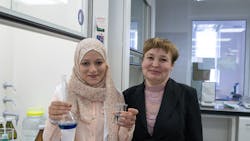An international team of scientists led by researchers at the Ural Federal University has synthesized a new sorbent that can remove heavy metals, such as copper and zinc, from water solutions.
The sorbent could be used for the treatment of heavy metal ions from mine, ore water, industrial wastewater, and drinking water. An article describing the results was published in the International Journal of Molecular Sciences.
“The basis of the synthesized sorbent is chitosan. It is a natural biopolymer that is obtained by alkaline treatment of chitin, which is found in algae and yeast and is a major component of the cell walls of fungi, arthropod exoskeletons and other invertebrates. Chitin is one of the most abundant renewable materials on Earth. Studies conducted by me and my students in Rwanda showed that the most accessible source of chitin, in addition to expensive crustacean shells, are insect organisms, which can be bred specifically to produce chitin biomass,” says Elena Kovaleva, head of the research group, professor at the UrFU Organic Synthesis Laboratory.
Chitosan itself has pronounced adsorption properties because it contains amino and hydroxyl groups that easily form complexes with metal ions. Chemists have improved the adsorption properties of chitosan by crosslinking it with glutaraldehyde and epichlorohydrin, and by further modification with diethylentriamine and the addition of monochloroacetic acid.
“In a series of experiments, we found that the most productive processes of adsorption of copper and zinc ions proceed at room temperature and the pH of aqueous solutions equal to 3.5. The maximum, 60 percent adsorption of copper and zinc ions from aqueous solution, occurred within 40 minutes in the first case and 60 minutes in the second,” says researcher Asmaa Abu El-Soad. “Thus, our modified chitosan demonstrated better adsorption characteristics compared with such well-known sorbents as activated carbon, bentonite, shabasite, cellulose, rice husk, and others.”
At the second stage of the work, the research group, which included scientists from Egypt, Italy, Saudi Arabia, and Jordan in addition to the UrFU staff, regenerated the modified sorbent by desorbing copper and zinc ions. As a result of experiments, scientists found that the removal of the largest amount of copper ions from chitosan is provided by solutions with certain concentrations of nitric acid. The same effect in the case of zinc ions is produced by urea.
“In other words, the sorbent we obtained is reusable. The copper and zinc extracted as a result of the adsorption and desorption cycle will return to industrial production. Thus, the technology of cleaning industrial wastewater, as well as drinking water with our sorbent will be environmentally friendly and cost-effective,” says Kovaleva.



